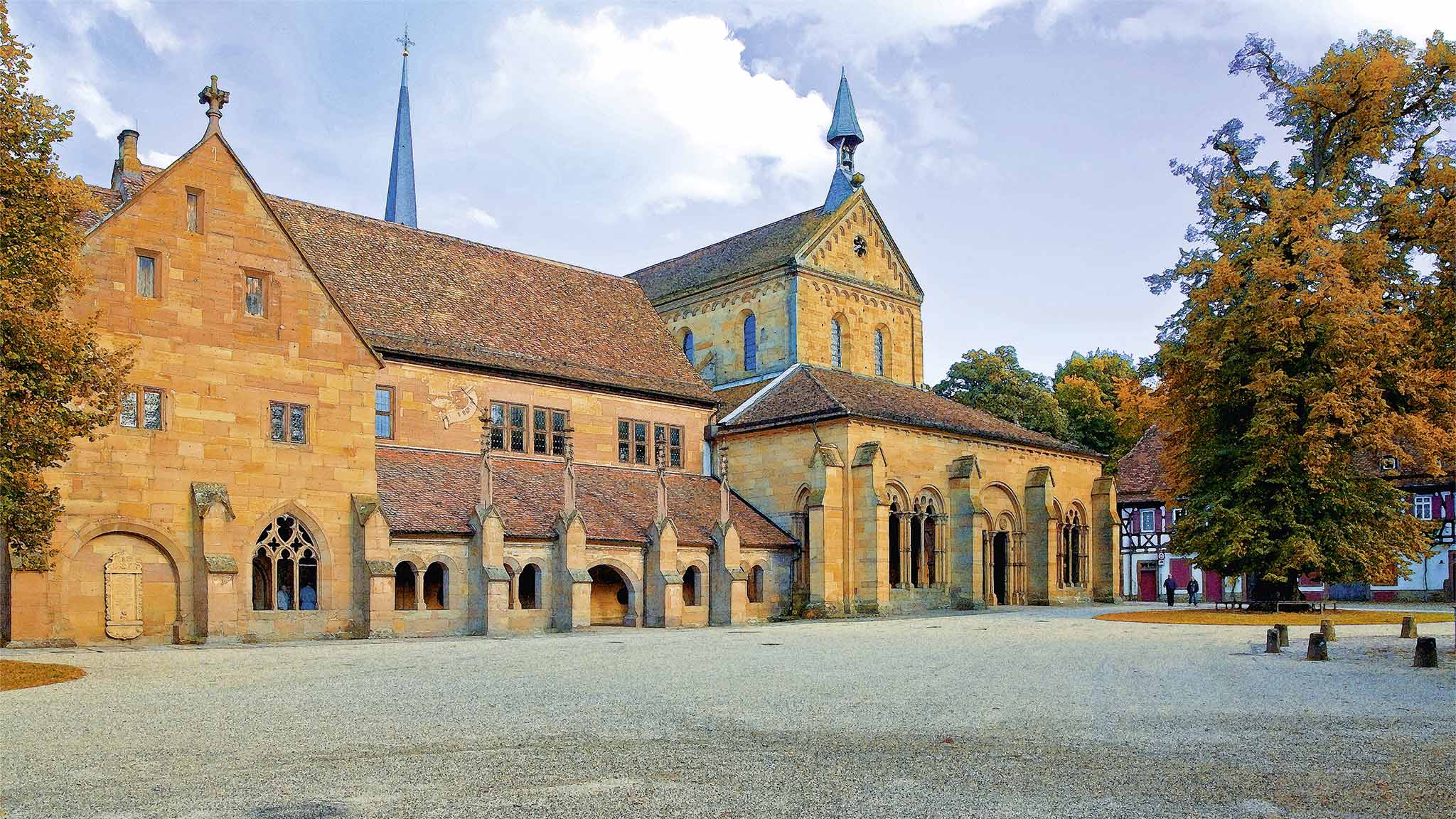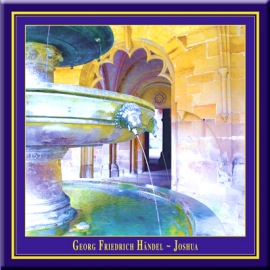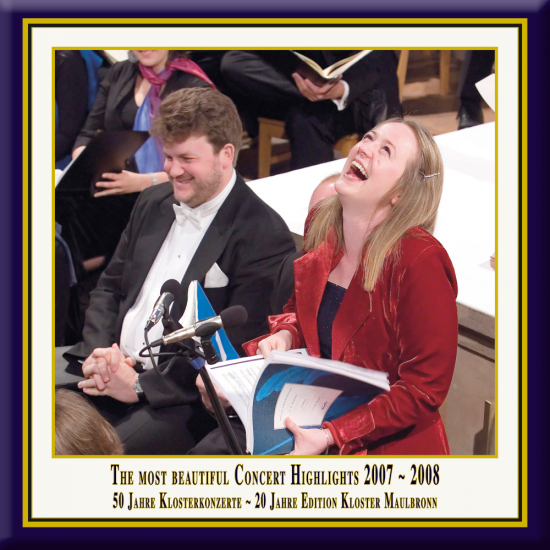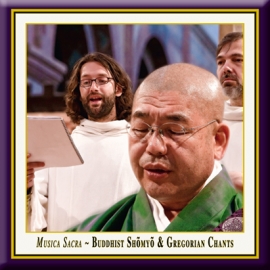Vol. 10: The most beautiful Concert Highlights 2007-2008
The most beautiful Concert Highlights
from Maulbronn Monastery 2007-2008
The 50th Anniversary of the Maulbronn Monastery Concerts
Anniversary Series, Vol. 10
Highlights from
George Frideric Handel:
Joshua, HWV 64
(May 19 & 20, 2007)
Franz Schubert:
Music for Men's Voices
(September 21, 2008)
The concert "Buddhist Shõmyõ & Gregorian Chants"
(June 20, 2008)
The concert "Music for Double Bass Ensemble"
(September 20, 2008)
Live recordings from the German UNESCO World Heritage Site Maulbronn Monastery
HD Recordings · DDD · Duration: c. 99 Minutes
Digital Album · 29 Tracks · incl. Digital Booklet



W
e have been documenting for 20 years the concerts at the UNESCO World Heritage Maulbronn Monastery. The concerts supply the ideal conditions for our aspirations. It is, above all, the atmosphere of the romantic, candle-lit arches, the magic of the monastery in its unadulterated sublime presence and tranquillity that impresses itself upon the performers and audience of these concerts. Renowned soloists and ensembles from the international arena repeatedly welcome the opportunity to appear here - enjoying the unparalleled acoustic and architectural beauty of this World Heritage Site, providing exquisite performances of secular and sacred music, documented by us in our Maulbronn Monastery Edition.
Josef-Stefan Kindler & Andreas Otto Grimminger, K&K Verlagsanstalt

Joshua by George Frideric Handel (1685-1759)
Of Handel's late oratorios, Joshua was one of the most successful. Of the operas composed after Samson, only Judas Maccabaeus was performed more frequently during the composer's lifetime, and the latter's popularity was mainly due to the fact that, after the first series of performances, "See the conqu'ring hero comes", originally written for Joshua, was included in it. Handel started to work on Joshua on 19 July 1747, only two weeks after he had finished writing the Alexander Balus oratorio. Eleven days later, the first act was already on paper. The second act was completed in an even shorter time - by 8 August - and the entire opus was finished by 19 August. The world première took place in Covent Garden on 9 March 1748. Joshua was one of four oratorios written in quick succession between 1746 and 1748 that all have strong military traits. In 1847, Judas Maccabaeus followed, a work that was extremely popular inasmuch as it was performed at least 33 times during the composer's lifetime. It appears clear that, after Judas Maccabaeus, Handel and his librettist, Thomas Morell, were at pains to repeat the successful recipe of a Jewish hero and triumphant choruses, but this time adding the romantic subplot that Judas lacked. Morell had hardly recovered from the exertions of Alexander Balus before he was already tackling the new libretto, based on a bloodthirsty account in the Book of Joshua in the Old Testament. He turned the campaigns against Jericho, Ai and the five kings into one dramatic block and extended the roles of Othniel and Achsa to create the background needed to provide romantic relief and to contrast the otherwise almost completely warlike plot. The unusual tempo of Handel's composition must have challenged Morell to the extreme and the result was more a sequence of events than a fully developed plot. But the characters are strong - Joshua an imperious/domineering (if also a sometimes unbearably conceited) hero, Kaleb the suitably patriarchal leader type, shortly before retirement and on the verge of leaving the battlefield forever, his daughter, Achsa, worried, occasionally disapproving and engaged to Othniel, who finds it difficult to strike the right balance between the role of the young warrior that has been thrust upon him and that of the devoted lover. Over and above all this, there is a small but important role for an angel. A later score gives this part to a tenor, but it is generally assumed that, as is to be expected, the angel was played by a female or boy soprano in earlier performances. As is the case with many of Handel's oratorios, the later performances underwent numerous rearrangements of the original score and for reasons that sometimes had little to do with music. The present version keeps to the score used in the 1748 performances, with the one concession that Handel's undated change to the second half of "Hark! 'tis the linnet" (1752?) is included. This is the only change made later that did not affect the original sequence of the movements. Handel had surprisingly few boy voices at his disposal to sing the upper parts of his choruses. However, as voices generally broke very much later in those days, we can assume that there were some excellent singers among them. Handel's soloists usually joined in the 'Tutti' parts (which most certainly must have put a huge strain on them during performances). Our 21st century choir has no need of such support. At three points in the score, Handel notes that the brasses ought to be brought in and there is a short rhythmic entry at each of these points, on the basis of which the musicians of the time (led by the first trumpet) then had to improvise the necessary music. Handel's lavish casting of the oratorio points to the fact that his performances were financially secured. The large orchestra comprises - apart from the usual strings, oboes and bassoons - two flutes, trumpets, horns and timpani, respectively. Moreover, certain 18th century reports on performances gave us the idea of including cembalo, organ and archlute as continuo instruments. The most stunning passages of Handel's Joshua make full use of brass and timbali, and the resulting music is very impressive. Dramatic events like the collapse of the walls of Jericho, the destruction of the city by fire, Joshua's ability to stop the sun and moon in their tracks and to rouse an army of demoralized soldiers to action, not to mention the return of the hero in triumph from the battle offer heroic material that would have inspired any composer. It might therefore come as no surprise that the fall of Jericho in Act II led Handel to use one of his wonderful 'thunder choruses' that incidentally also greatly impressed Hadyn when he heard it during a lavish performance at Westminster Abbey in 1791. Supposedly, he was familiar with the music, but was only half aware of its effect until he actually got to hear it. In any case, Hadyn was convinced that only a genius like Handel could ever have written such an outstanding composition or could indeed write one like it at any point in the future. The solemn march around the Ark of the Covenant, which hastens the destruction along, is also one of Handel's most beautiful compositions, and its amazing solemnity is impressive, while Kaleb's aria that follows it, "See the raging flames arise" turns out to be wonderfully dramatic. Othniel's "Place danger around me" is an equally outstanding Handel aria. Joshua was also the original source for the chorus "See the conqu'ring hero comes" that was only put into Judas Maccabaeus when its potential as a crowd-puller was recognized after the first performances of Joshua. At the same time, the quieter, more contemplative moments also deserve a mention: Kaleb's resigned aria "Shall I in Mamre's fertile plain", the heavenly chorus that follows it and the chorus of the vanquished Israelites, "How soon our tow'ring hopes are crossed as well as Othniel's "Nations who in future story" are all examples of Handel's best lyrical style. And between the triumphs and catastrophes of the battle, the scenes with Achsa offer additional contrast, with arias ranging from the pensive "Oh, who can tell" to the bird calls in "Hark! 'tis the linnet" and the joyful, ever-popular "Oh had I Jubal's lyre".
This live recording of "Joshua" is part of a cycle of oratorios and masses, performed in the basilica of Maulbronn Abbey under the direction of Jürgen Budday. The series combines authentically performed oratorios and masses with the optimal acoustics and atmosphere of this unique monastic church. This ideal location demands the transparency of playing and the interpretive unveiling of the rhetoric intimations of the composition, which is especially aided by the historically informed performance. The music is exclusively performed on reconstructed historical instruments, which are tuned to the pitch customary in the composer's lifetimes (this performance is tuned in a' = 430 Hz).
Music for men's voices by Franz Schubert (1797-1828)
Within Schubert's vocal works, his approximately 130 works for polyphonic singing occupy a very significant place. The cast could not be more varied: female, male or mixed voices sing in duet, trio, quartet, quintet, double quartet, choir, sometimes accompanied by piano or other instruments, in many cases also a cappella. Formally there is also a rich abundance to be observed, ranging from the canon to simple strophic songs to through-composed songs and extended cantata-like formations. With this concert, titled "Goldner Schein deckt den Hain" (Golden sparkle covers the grove), a program of literary sensibility can be heard here. The focus is on male ensembles and songs based on poems by Friedrich von Matthisson, who - praised by Schiller for the musical beauty of his verses - invokes in his poems love, friendship and especially nature as poetic ideals. Thus, the content of the content ranges from the spirit of love to the enjoyment of nature, concludes with Op. 17 is one of Schubert's two a cappella cycles and approaches death as a central theme of the Viennese composer - admittedly in typical Schubertian transfiguration and beauty.
Meaningful dialogue between religions is no doubt one of the most pressing challenges of the modern world. Developments over the past few years clearly confirm what a significant role this aspect of human communication represents. Despite breathtaking technological breakthroughs and the related trend of rational scepticism, man still remains a religious creature. Ignoring this sphere of human personality not only leads to an impoverishment of the spiritual culture of a nation, but also to mutual estrangement of nations. And so what a wonderfully enriching experience it is then two cultures meet in mutual dialogue rather than confrontation. As a biblical quotation has it, Spiritus flatubivult - the Spirit blows wherever it pleases. These words suggest an image of the unbound "blowing of God's spirit" traversing all religious traditions. It is precisely by seeking this spirit that we can liberate ourselves from long established differences and share the common "message" of religions. Many would agree that music plays an important role in such communication, crossing barriers and working as a kind of universal language. The intention of the Tendai monks and the Schola Gregoriana Pragensis ensemble was to create a dialogue of two spiritual cultures based on the musical repertoire of the Buddhist and the Christian tradition. Thus, this recording is the fruit of mutual collaboration at concerts and liturgy in Prague in 2000 and a tour of Japan in 2005. These meditative encounters focus on interesting contrasts in the two musical languages and expressions, at the same time seeking common elements present in both traditions. Parallels can be found, for example, in the recitation of the sacred text or in the interpretation principle of alternating a soloist with a choir, which overlaps the boundaries of confession repertoires. Another striking feature is the tonality based on the pentatonic scale appearing both in shomyo singing and Gregorian chant. Gregorian chant is the earliest liturgical singing of the western Christian tradition. Its roots reach back to the first centuries of the Christianera. The core of this sacral repertoire was established in about the second half of the 8th century under the reign of Charles the Great. Homophony and Latin texts are typical features of this style. Most prominent in the Gregorian chant is the singing of psalms, sometimes conceived in a simple recitation (as in the psalm Misere mei Deus and the antiphon Alieni insurrexerunt) and in others (such as the tractus Deus, Deus meus) in a richer melodic shape. While the core of the repertoire has remained more or less unchanged since the early Middle Ages, liturgical singing is still a dynamic phenomenon, having incorporated new musical forms and accepting even polyphonic compositions. Gregorian chants on this recording draw predominantly from the earliest part of the repertoire (around the second half of the 8th century), as it seems to resonate best with the meditative feeling of shomyo singing. To create contrast, several examples of late medieval music including a polyphonic composition (the conductus Mundus a munditia) have been selected for the recording. There are also two songs of Czech origin. The procession antiphon Sedit angelus from the Easter Vigil has survived in Bohemia in an accompaniment of an interesting two voice verse. Ave virgo gloriosa also represents the repertoire of Czech sacred songs (cantiones) of the late Middle Ages. It is complemented interestingly on this recording by the "hum" of the recited Lotos sutra.
The concert "Bassiona Amorosa · Music for Double Bass Ensemble"
As an International Contrabass Ensemble, they know how to excite and engage the audience in Europe and America in concerts, on CDs, on the radio, and on TV with never expected, varied, interesting programs, which include music from the early renaissance, baroque and classical period to arrangements of light music, and have done so since their foundation in 1996. The reason for this special attraction is the incredible sound refinement and the unusual virtuoso performance. The sense of this "special touch" bring these exceptional artists along from their home countries Slovakia, Russia, Czech Republic, White Russia, Yugoslavia, Georgia and Ukraine. The formation consists of Master Class students of Prof. Trumpf, the leader of the Ensemble, at the State Conservatory of Music in Munich. Carthy musicianship, Slav melancholy with classical education - now formed through the same school - merge in unique symbiosis. Unbroken temperament and charm fascinate the audience. In its fourteen-years history, Bassiona Amorosa performed in nearly 500 concerts; seven CDs have been published so far; the ensemble was subject of three short films shot by the Bavarian Television Station and the WDR (West German Broadcasting Company). The third USA tour in June 2003 received a sensational reception by the audience. In Lucerne in September 2003, Bassiona Amorosa received from the European Culture Foundation Pro Europa the "European Quartet Prize 2003".
P
ublishing Authentic Classical Concerts entails for us capturing and recording outstanding performances and concerts for posterity. The performers, audience, opus and room enter into an intimate dialogue that in its form and expression, its atmosphere, is unique and unrepeatable. It is our aim, the philosophy of our house, to enable the listener to acutely experience every facet of this symbiosis, the intensity of the performance, so we record the concerts in direct 2-Track Stereo digital HD. The results are unparalleled interpretations of musical and literary works, simply - audiophile snapshots of permanent value. Flourishing culture, enthralling the audience and last but not least also you the listener, are the values we endeavor to document in our editions and series.
The concerts at the UNESCO World Heritage Maulbronn Monastery supply the ideal conditions for our aspirations. It is, above all, the atmosphere of the romantic, candle-lit arches, the magic of the monastery in its unadulterated sublime presence and tranquillity that impresses itself upon the performers and audience of these concerts. Renowned soloists and ensembles from the international arena repeatedly welcome the opportunity to appear here - enjoying the unparalleled acoustic and architectural beauty of this World Heritage Site, providing exquisite performances of secular and sacred music, documented by us in our Maulbronn Monastery Edition.
Andreas Otto Grimminger & Josef-Stefan Kindler, K&K Verlagsanstalt
George Frideric Handel (1685-1759):
Joshua
The unedited version from 1748
of the English Oratorio HWV 64,
performed by the Maulbronn Chamber Choir
and the Hanoverian Court Orchestra,
conducted by Jürgen Budday
on May 19 & 20, 2007
Words by Thomas Morell (1703-1784)
1. Act I: Introduction [1:39]
for Orchesta
2. Act I: Haste, Israel haste [2:40]
Air of Joshua · Soloist: Mark Le Brocq (Tenor)
3. Act I: Hark, 'tis the linnet and the thrush! [5:53]
Air of Achsah · Soloist: Miriam Allan (Soprano)
4. Act I: May all the host of Heav'n attend him round [1:37]
Chorus of Israelites
5. Act II: A Solemn March [1:51]
for Orchestra
6. Act II: Glory to God! [5:44]
Solo of Joshua & Chorus of Israelites · Soloist: Mark Le Brocq (Tenor)
7. Act II: O thou bright orb, great ruler of the day - Behold, the list'ning sun the voice obeys [3:00]
Solo of Joshua & Chorus of Israelites · Soloist: Mark Le Brocq (Tenor)
8. Act III: Hail! Mighty Joshua, Hail! [3:54]
Chorus of Israelites
9. Act III: Shall I in Mamre's fertile plain - For all these mercies we will sing [5:17]
Air of Caleb & Chorus of the Tribe of Judah · Soloist: James Rutherford (Bass)
10. Act III: See, the conqu'ring hero comes! [3:00]
Chorus of Youths / Chorus of Virgins / Full Chorus
11. Act III: Oh, had I Jubal's lyre [2:37]
Air of Achsah · Soloist: Miriam Allan (Soprano)
12. Act III: The great Jehovah is our awful theme [1:58]
Chorus
Franz Schubert (1797-1828):
Music for Men's Voices
Performed by Thomas Seyboldt and the Vocal Quartet "Schubert High Four":
Markus Schäfer & Hubert Mayer (Tenor),
Hans Christoph Begemann & Cornelius Hauptmann (Bass),
Frank Laffin (Baritone, Guest), Thomas Seyboldt (Leader & Piano)
on September 21, 2008
13. Geist der Liebe, Op. 11, No. 3, D 747 [4:28]
Lyrics by Friedrich von Matthisson (1761-1831)
14. Vier Quartette, Op. 17: IV. Die Nacht, D 983 C [2:58]
Lyrics by Friedrich Wilhelm Krummacher (1796-1868)
15. Goldner Schein deckt den Hain, D 357 [2:25]
Lyrics by Friedrich von Matthisson (1761-1831)
16. Geist der Liebe, D 414 [3:30]
Lyrics by Friedrich von Matthisson (1761-1831)
Musica Sacra:
Buddhist Shõmyõ & Gregorian Chants
A dialogue of two spiritual cultures
based on the musical repertoire of the Buddhist and the Christian tradition,
performed by the Ensemble "Schola Gregoriana Pragensis"
and "Gjosan-rjú Tendai Sómjó" (Buddhist Monks from Japan),
conducted by Saikawa Buntai & David Eben
on June 20, 2008
17. Sorai kada · Canticle
Psalm 51: Miserere mei Deus · Have mercy on me, God [9:58]
18. Kudshó Shakudshó [5:27]
Chants and rattles to drive out evil forces
19. Graduale Iustus ut palma [3:41]
The righteous blooms like a palm tree
20. Amida-kyo · An Amida-Sutra
Kyrie IV · Lord, have mercy [9:14]
21. Jinriki-hon · About the divine strength, 21st Book of the Lotus Sutra
Cantio Ave virgo gloriosa · Greetings, Queen of Heaven [3:43]
Bassiona Amorosa:
Music for Double Bass Ensemble
Performed by the Ensemble "Bassiona Amorosa":
Ljubinko Lazic, Sergej Konyakhin, Jan Jirmasek, Giorgi Makhoshvili & Jang Kyoon Na (Double Basses)
& Prof. Klaus Trumpf (Leader)
on September 20, 2008
Giorgi Makhoshvili:
22. Valse Caramel [4:43]
Soloist: Giorgi Makhoshwili
Johann Sebastian Bach (1685-1750):
23. Harpsichord Concerto No. 5 in F Minor, BWV 1056: II. Arioso [3:19]
Arranged for 4 Double Basses
Francois Rabbath:
24. Kobolds [3:46]
Stefan Schäfer:
25. Gargantua [2:54]
Sound & Recording Engineer: Andreas Otto Grimminger
Production & Mastering: Andreas Otto Grimminger & Josef-Stefan Kindler
Photography: Josef-Stefan Kindler
Artwork & Coverdesign: Josef-Stefan Kindler







